The uncertainty and doubt surrounding most North American Indian history are partially removed from the Six Nations. They, of all American Indians, have best preserved their traditions. Besides, their system was so complete, and their government so unique and so well fitted to the people, that from the earliest European arrival they have been constantly written about. Their small numbers, compared with the enormous country they occupied and the government they originated with their deeds of daring, will always excite surprise. Their league, tribal and individual characteristics and personal strength of will, together with their great courage and prowess, account for their success in war and the methods, which brought comfort and peace.
They made war or peace with equal facility, holding with a death grasp to their old ideas and traditions, conquering and absorbing tribes, and getting the control and government of the country from the Carolinas on the, south to the lakes on the north and the Mississippi on the west. The Mohawk war whoop was the terror of aboriginal life, and the signal fires of the Iroquois League, illuminating the hills and valleys of the Atlantic coast, meant danger to the outlying tribes. Their phenomenal fighting capacity, coupled with the rapidity of movement and power of concentration of their fighting men, gave the impression of a vast number of warriors. It can be stated with almost a certainty that the league of the Iroquois, since the advent of the European on the American continent and up to 1880, never exceeded 15,000 persons, and it never had an available fighting force of more than 2,500 men.
Condition Of The Six Nations In 1890
The special agent found no places on any of the reservations for the sale of intoxicating liquors. Such places are unlawful. Intoxicating liquors, however, are sold to the Indians by white men or women living off the reservations. Houses for immorality are foreign to the social life and surroundings of these people, and gambling among the Six Nations is in the line of single risks, as opportunity offers.
The struggle now within the Six Nations for control of their government lies between the pagan and Christian elements, and, in addition, they have to war with the wiles of the white man. Official corruption has been noted in the past among those high in authority, but this is now being rapidly remedied. The Six Nations are in most danger from without. The pagans are those holding to the beliefs of their fathers and opposing the white man and his methods. The Christian element means those who accept Christianity as a doctrine. As far as personal morals and the daily life of most of these people are concerned, the difference is merely technical, the word of a pagan being considered as good its that of a christian, and, in the view that the state has nothing to do with one’s profession of creed, among the Indians a self-reliant pagan is preferable to a dependent christian. In the league of the Iroquois the largest personal independence consistent with the safety of the league is permitted. The Six Nations of New York have generally asked the Great Father, the Congress, and the New York legislature to let them alone. They are self-sustaining and much farther advanced in civilization than any other reservation Indians in the United States, and as much as an average number of white people in many localities. They have borne the burdens of peace with equanimity and met the demands of the war for the Union with patriotism and vigor. Envious Caucasians, hungering for the Indians landed possessions in New York, as elsewhere, have been active and earnest in ends to absorb their substance. They have been kept from doing so thus far through the efforts of earnest and active fair minded people. The Six Nations have been charged with being pagans, heathens, and bad citizens generally, but investigation shows the latter charge to be false. In the matter of creed, among the Tuscaroras there is not a pagan family recognized as such; among the Tonawandas and Onondagas very nearly two-thirds belong to the pagan party, several of the most influential men having recently left the christian party for personal and political reasons.
Of the Cattaraugus and Allegany Senecas, a, majority belong to the pagan party, but of the Cornplanter Senecas and the St. Regis Indians none are pagans.
In the battle for progress the Christian party has taken the offensive or progressive side, and at an early day may gain control. The difference between the pagan and the christian is most marked in their material interests, the christian more readily grasping modern ideas and methods of life, with their educational incentives. As a rule the pagan falls behind in the use of farm machinery, in advanced crop culture, in the education of his children, and matters of essential public spirit.
On all the reservations crimes are few, stealing is rare, and quarreling resulting in personal assault, infrequent. Respecting the St. Regis Indians, the only suits of a criminal nature for a long time grew out of resistance to the game laws, which stopped their netting on their own waters. The total of local offenses during the year was 10 in an Indian population of 5,133 on reservations in New York.
Except in the matter of marriage and divorce, that is, with respect to the police laws, they are shown to be as law-abiding as the same number of average white people, and no communities elsewhere, white or otherwise, are known where persons and property are more safe, or where male or female can walk unattended at night with greater security.
Diseases resulting from association with whites in early times are being gradually eliminated. This has reduced mortality and increased longevity. The growth of self-reliance is especially noticeable. This tends to greater diffusion of agricultural-products, better homes, and clothing.
There is scarcely any poverty among the Six Nations, but 3 paupers being noted on the schedules. The percentage of deaths under one year of age is low. The percentage of advanced ages without chronic impairment of faculties is beyond that of any other like number of people in the United States. The family increase and surviving members of families, as at St. Regis, preclude the possibility of general immorality in their homes.
Portions of the Bible, and especially hymns, have been translated into the Iroquois dialect, and at St. Regis (Catholic) the Latin forms, Psalter included, have been translated into Iroquois, the Mohawk dialect; but the books used in the schools, the Bible in many of the churches, and the international Sunday school lessons are in English. The adult Indians prefer to pray in their own language, their thoughts or desires flowing naturally without the mental abstraction necessary in finding the English word for their exact meaning.
Statistics of the English Language among The Six Nations in New York and Pennsylvania In 1890

The English Language, The total Indian population of the Six Nations of New York on reservations is 5,133. Of these 2,844 can speak English and 1,985 can not. The Indian population of the Cornplanter reservation in Pennsylvania is 98, of whom 57 can speak English and 35 can not. Children not able to speak a language are not noted, and some absentees were omitted.
The great number who can not speak or read the English language is a drawback to the advancement of the Six Nations. Officials are sometimes elected who can not read the laws of New York or of the United States, and almost a majority of this people are cut off from the information and advantages obtained through the reading of newspapers and general literature. The young, however, are usually brought up to read and speak the English language.
The Legal Status Of The Six Nations Of New York, The total acreage of the reservations of the Six Nations is 87,327.73, with an Indian and adopted population of 5,203, or 16.78 acres for each person. The value of the whole is estimated at $1,810,699.60.
The law and facts show that the reservations of the Six Nations of New York are each independent, and in some particulars as much sovereignties, by treaty and obligation, as are the several states of the United States. The St. Regis reservation, however, differs somewhat from the others. The lands within these reservations carry with them the conditions of the grant.
The incidents of the enumeration of the Seneca Nation show a strong desire on the part of the advanced portion to break away from old time ideas and to keep abreast with their white neighbors. The reorganization of the Iroquois agricultural society was a step forward.
The members of the Six Nations of New York residing on reservation or living in tribal relations do not vote at county or state elections, nor do they pay taxes to the counties or the state. They are therefore Indians not taxed. They have a constitution, and the Senecas have a charter from New York. They are amenable to national and state courts or laws only in respect to crimes except the St. Regis Indians. 1
If the Iroquois, native or foreign born, want to become citizens of the United States they must renounce allegiance to their own people; but if those of the Six Nations of New York become such citizens they can not carry their real property interest with them so that it will be subject to levy and sale for debt on contracts. This, in fact, is at present a practical inhibition in their way to citizenship. The several reservations belong to them (St. Regis differs somewhat from the others), and neither the state of New York nor the United States can legally break them up without the Indians’ consent.
The several tribes and bands of the Six Nations differ somewhat in respect to land holdings and titles on or within the several reservations. A lien or preference, in case of sale, called the “Ogden Land Company’s rights”, hangs over the Cattaraugus and Allegany Senecas, but the United States extinguished it as to the Tonawanda Senecas. The title to these reservations is in the nation, and the members are therefore at common law “tenants in common”. Each owns his undivided share absolutely, independent of the United States or the state of New York. The individuals, however, only hold a fee equivalent to the ownership of the land they improve, with power to sell or devise among their own people, but not to strangers. It is a good title. The nation itself can not disturb it Within the Six Nations each head of a family or a single adult has the right to enter upon unoccupied land, build upon it, and improve it, thereby acquiring a title, with authority to sell to another Indian or devise the same by will; but all these transactions must be between Indians.
The Cornplanters are Senecas of the Seneca Nation, voting with them for officers annually, and having a representative in the nation’s council. Although in Warren county, Pennsylvania, they inherit a common interest in all the Seneca lands in New York, draw like annuities, but do, not vote in New York except as Indians for their own officers, namely, officers of the Seneca Nation. They are also heirs in Pennsylvania of Cornplanter, the probate court of Warren County, Pennsylvania, having partitioned the inheritance of Cornplanter (a special gift of gratitude from Pennsylvania) among them, inalienable except among themselves. They have been admitted to the privileges of citizenship in that state.
The conclusion is irresistible that the Six Nations are nations by treaty and law, and have long since been recognized as such by the United States and. the state of New York, and an enlightened public Will surely hesitate before proceeding to divest these people of long established rights without their consent, rights recognized and confirmed in some cases by the immortal Washington and by more than a hundred years of precedents and legislation.
The Six Nations of New York Indian question can not be settled permanently without action on the Ogden company’s claim by the Congress of the United States.
Peacemaker Courts, The peacemaker courts are peculiar to the Seneca Indians of New York. They exercise probate jurisdiction and jurisdiction over minor offenses. Appeal may be taken to the council of the Seneca Nation proper on the Allegany and Cattaraugus reservations and to the separate council of the Tonawanda Senecas. The term of office of a peacemaker is for three years, one being elected annually for each reservation, but those of the Tonawanda band, as with all its officers, have no official relation to the other bands of Senecas.
The president of the Seneca Nation sits as judge upon the impeachment of a peacemaker. Among the grounds of impeachment is taking ‘A bribe, or, by relationship or otherwise, having interest in a case.
Petitions, summonses, answers, all pleadings, returns of process, and record follow the forms prescribed for state courts of like jurisdiction. A record of proceedings is duly kept.
During 1889 a contested election among the Tonawanda band was, upon application, decided by the state courts of New York, sitting at Batavia, Genesee County, in which county the Tonawanda reservation is in part situated.
United States Indian Agent, The civic establishment of the United States Indian agency at Akron, New York, consists of an agent, whose salary is $1,000 per year; a messenger, at $400 per year; a physician, at $200 per year; and an interpreter, at $150 per year.
The agency contains 1 frame building, the property of the United States, of the value of $250. As the office of the agent is usually at his residence, change in the incumbent removes the office.
The United States Indian agent receives from the Commissioner of Indian Affairs annually and distributes, under bond, both cash annuities and goods, except for the St. Regis Indians, who receive neither from the United States, and over whom the agent has no immediate charge.
The Indian agent is the official to whom are referred by the Commissioner of Indian Affairs all complaints by Indians preferred against each other or against the white people, and upon his investigation and report the Commissioner initiates relief or other action. He is especially charged with the investigation of all cases of trespass upon their lands or other rights, as also illegal sales of intoxicating liquors to the Iroquois, and as their protector places in the hands of the United States district attorney the proper evidence upon which to prosecute suits at law against offenders. It is also his duty to investigate and report upon all crimes of Which the state courts of New York have jurisdiction; also to interest himself in local troubles between the Indians themselves, and to report annually to the Commissioner of Indian Affairs all births and deaths, as the basis of the annual distribution of goods or money.
The New York state agent and attorney have no official connection with the United States Indian agent. The former acts for the Onondaga Indians, and pays the state annuities to the Six Nations, while the latter, under special law, acts for the St. Regis Indians. Each reservation has a state school commissioner.
The League Of The Iroquois From 1660 To 1890
In 1890 the census of the United States and the official report of Canada not only show that the league of the Iroquois probably numbers more than it ever has hitherto since first met by Europeans but that it is steadily increasing.
League of the Iroquois in the United States, 1890 7,387
League of the Iroquois in Canada, 1890 a 8,483
Total 15,870
Tho following statement has been furnished through the kindness of Mr. E. D. Cameron, superintendent of Indian affairs at Brantford, Canada;
| Oneidas of the Thames | 715 | Iroquois of St. Regis * | 1,100 |
| Mohawks of Bay of Quinte | 1,056 | Iroquois of Gibson | 137 |
| Six Nations of Grand River, Brantford | 3,238 | Iroquois of the Lake of Two Mountains | 375 |
| Iroquois of Caughnawaga* | 1,722 | Total | 3,483 |
League Of The Iroquois In Canada In 1890
The Iroquois of Grand river are in detail as, follows; Mohawks, 1,344; Oneidas, 241; Senecas, 183; Cayugas, 865; Onondagas, 325; Tuscaroras, 327; total, 3,288.
League Of The Iroquois In The United States In 1890
Six Nations of New York 5, 239
Senecas and Onondagas in Warren county, Pennsylvania 98
Total in New York and Pennsylvania 5,337
Senecas and Cayugas at Quapaw agency, Indian Territory 255
Members of the league enumerated, residing in Connecticut, Massachusetts, and New York 79
Oneidas in Wisconsin 1,716
Total in the United States 7,387
The following statement shows the total number of the league of the Iroquois, estimated and known, at the several periods named:

a Not including emigrants Mohawks, Onondagas, etc.
There is no record given of the number of the league between 1791 and 1877.
The emigration to Canada of a large portion of the league left a smaller portion in the United States after 1790. In 1868 the Iroquois in Canada (all of the league) were given at 5,881; in 1874, 6,845; in 1875, 6,893; in 1876, 6,953; in 1890, 8,483.
In 1877 the total number of the league of the Iroquois in Canada and the United States was estimated to be 13,668, and in 1890 it was 15,870. The rate of increase in Canada and the United States is now about the same.
The Cherokees of Indian Territory and the Eastern Cherokees, along with the Wyandottes (Wyandot, Wendot) of Quapaw agency, Indian Territory, are of Iroquoian stock, but are not included in the membership of the league.
Total Population if the Six Nations Of New York at Several Periods From 1796 to 1890, Inclusive.

a. Oneidas omitted (removed west).
b. Not including the Cornplanter Senecas in Warren County, Pennsylvania, 98 in number, which would give a total of 5,337, nor 70 white and colored additions by marriage.
Indian and Adopted Population of the Six Nations in New York and Pennsylvania: 1890

The total population of the Cornplanter reservation, Warren County, Pennsylvania, and adjoining the Allegany Seneca reservation, New York, is as follows: Onondagas, 11; Senecas, 87, and 1 white man; total, 90.
The total population of the Six Nations reservations in New York and 106 Oneidas off reservation is 5,309. This includes 70 white and colored persons.
The total Indian population of the Six Nations reservations in New York and 106 Oneidas off reservation is 5,239.
Vital Statistics of New York Indians in 1890
The total Indian population of the Six Nations reservations in New York is 5,133. The births during the year were 181; deaths 156; gain by births over deaths, 25. All reservations gained by births except Tuscarora, where the net loss by deaths was 6, and St. Regis, where births and deaths were equal. The deaths by consumption were 39, or 7.6 to the 1,000 of population. The births 35.3 to the 1,000, and the total deaths 30.4 to the 1,000.
The several causes of deaths are given in detail in the table on the following page. The deaths from June 30,1889, to June 30, 1890, included 3 persons between the ages of 90 and 100, 4 persons between the ages of 80 and 90, 4 persons above 78 but less than 80, and 5 persons between the ages of 60 and 75, in a total Indian population of 5,133.
At the Cornplanter reservation, Warren County, Pennsylvania, with an. Indian population of 98, the births were 4 and the deaths were 5. Of the latter, 3 were infants under 1 year of age and 2 were adults, 1 from pneumonia and 1 from consumption.
Births and Deaths and Causes of Deaths Among the Indians of the Six Nations in New York and Pennsylvania in 1890, As Far As Known
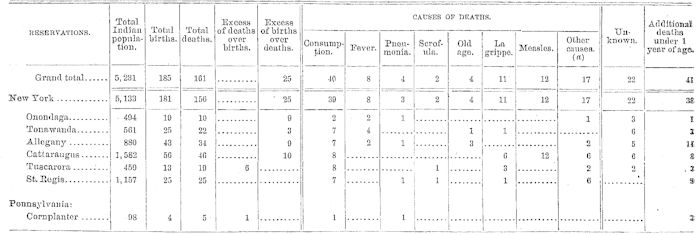
a Contains 1 paralysis, Onondaga; 1 lung fever, 1 accident, Allegany; 1 typhoid fever, 1 brain fever, 1 smallpox, 1 neuralgia, 1 spinal complaint, 1 kidney trouble, Cattaraugus; 1 suicide, 1 cholera morbus, Tuscarora; 1 heart disease, 1 blood poison, 1 childbirth, 1 croup, 1 rheumatism, 1 sudden death, St. Regis.
Statistics of Cripples and Acute, Chronic, and Other Diseases Among The Indians of The Six Nations In New York and Pennsylvania: 1890.

Families, Population, And Persons Above 60 Years of Age Among The Indians Of The Six Nations On Reservations In New York And Pennsylvania: 1890.
Persons above 60 years
a Excluding 106 Oneidas, not on reservations, and 70 white and colored.
The age of 60 years, the ordinary limit of life assurance, is made the basis of comparison. By the American table of mortality adopted by the state of New York as the standard for valuation of policies, the “expectation” is at 10 years of age, 48.7 years, or the age of 58.7. More than 5.2 per cent of the living persons given above have passed the age of 60 years.
At the Cornplanter reservation, Pennsylvania, 6 persons were above the age of 60 and none above 70 years.
Marriages And Divorces Among The Six Nations In New York And Pennsylvania For 1890.

Many of the marriages are without any form of legal union or separation, but an almost universal conviction is gaining ground that marriage must be held binding, whatever its form, unless a divorce be secured upon separation. The table headings given above are transcripts of the returns made by the enumerator. The several tribes have various ideas of the meaning of the word bigamy, which accounts for the apparent inconsistency in the headings.
Felonies committed by members of the Six Nations are cognizable under the laws of New York or the United States. No felonies were reported during the census year and but few trivial offenses, except intoxication. The number of Indians in jail or prison for offenses against person or property during the year in an Indian population of 5,133 was as follows: Onondaga, 1; Cattaraugus, 9; Tuscarora, 3; St. Regis, 3; total, 16. These offenses were tried by Indian courts on the reservations, except at St. Regis.
Religious And Church Statistics For 1890
The total number of churches on the 6 reservations in New York is 12. Some congregations, however, worship in private houses or halls. The churches cost $25,400. The total number of communicants is 1,074. The cost of the church service was $6,887, of which the Indians contributed $1,262. Eighteen ministers and missionaries-were engaged in the work during the year. Details are given in the following table of “denominations.”
On the Cornplanter reservation, Pennsylvania, there is a Presbyterian Church with 39 members.
The pagans of the Six Nations assemble for their business, ceremonies, and exercises either in the council houses, one of Which belongs to each of the nations (except the Tuscaroras), or in. groves or private houses.
Church Statistics
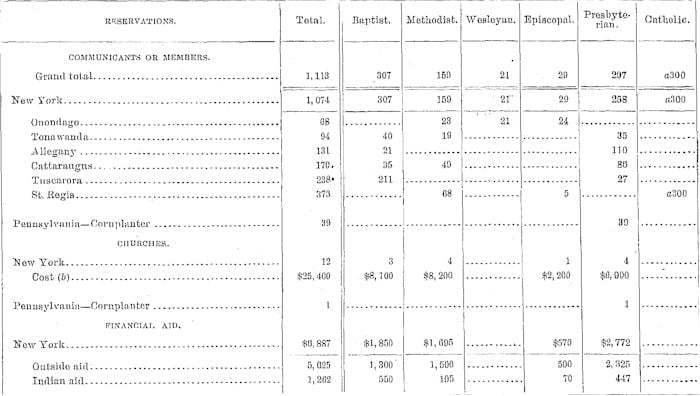
a. Worship at the Catholic church on the Canadian side.
b. Estimated total previous cost, with changes and repairs.
The churches are described in detail on later pages.
Schools, The pay for teachers on these reservations varies from $250 to $276.50 per year. The total number of teachers is 28; schools, 27; children of school age on the reservations, 1,429; largest daily attendance, 714; average attendance, 306; school accommodations, 1,025. The total cost of these schools to the state of New York for the year is placed approximately at $8,360.69, or an average of $27.32 for each of the 306 in attendance.
The record of school attendance for some portion of a year would include attendance even for a day, and a large number of children were present but a few days during the entire school year. In this connection the attendance for one month or more is indicated respecting each school, with notice of exceptional cases of remarkable punctuality, in one case of an attendance with but one day’s absence, unless sick, for more than 7 years.
The attendance is separately indicated of pupils under 6 and over 18 years of age.
Statistics Of Schools Among The Six Nations Of New York For 1890

a These two items, “Number of weeks taught” and “Cost per annum”, are from the official reports of the state of New York.
Adding the number reported as under 6 and over 18 years of age increases the substantial attendance to 770. The data are from reports of superintendents, examination of the registers, and personal visits to the schools. The large percentage of children of school age among the St. Regis Indians is due to the remarkable size Of families on that reservation, there being now, as reported under the head of “St. Regis families”, 194 children living out of 254 born in 24 families. One hundred and seven children under 16 years of age were also educated at the Thomas Orphan Asylum, viz: from Onondaga, 6; Tonawanda, 6; Tuscarora, 13; Allegany, 20; Cattaraugus, 57; and St: Regis, 5. The state of New York pays the expense of the Indian schools. The Indians supply fuel and care for the schoolhouses and the state attends to the repairs.
Statistics Of Occupations
Sewing Machines. And Pianos And Organs, There are 283 sewing machines on the reservations distributed as follows: Onondaga, 25; Tonawanda, 37; Allegany, 48; Cattaraugus, 120; Tuscarora, 20; St. Regis, 27; Cornplanter, Seneca, Pennsylvania, 6. There are 56 pianos and organs, distributed as follows: Onondaga, 11; Tonawanda, 11; Allegany, 11; Cattaraugus, 11; Tuscarora, 8; St. Regis, 4.
The following statistics show that 1,738 of the Six Nations in New York and Pennsylvania work for a living, of whom 712 males are laborers and 590 males are farmers. Many minors were enumerated as laborers and farmers. The column of occupations gives details of all callings.
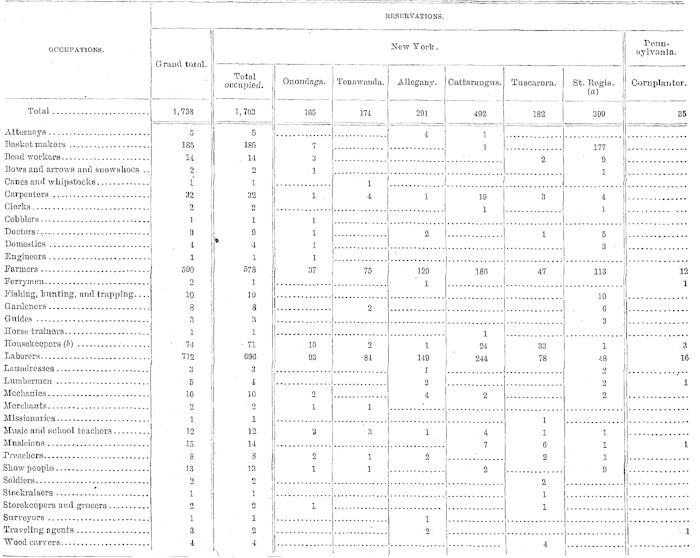
a. Among the St. Regis Indians many children are basket makers; The adults of both sexes engaged in basket making do not number more than 50.
b. Housekeepers are generally widows or housekeepers for widowers.
The Area and Condition of the Reservations
In Indian reservations, recorded or personal land holdings and titles are not usually found. Allotments and assignments to tracts proceed on the order of the allotting agent. No allotment can be made of the Six Nations lands in the customary manner, nor can an assignment in severalty of them he had on the basis of a common and general division or absolute removal. The present occupancy or recorded titles would prevent this.
Land Titles And Tenures, While land tenure among the Six Nations, as a rule, is secure in the families enjoying it, the evidence of title for many years depended upon visible possession and improvement, rather than upon the record evidence common to white people. Verbal wills, recited at the dead feasts in the presence of witnesses to the devise, were usually regarded as sacred, and a sale with delivery of possession was respected when no written conveyance was executed. Of late years written wills have become common, and among the Senecas, with their peacemakers’ and surrogate judges, the proof of a will conforms very nearly to similar proceedings in the state probate courts. The clerk of the Seneca Nation keeps a record of grants made, by the council. Generally the clerk, whether of chiefs, as with the Onondagas and Tuscaroras, or of trustees, as with the St. Regis, has the custody of the records of official proceedings respecting grants or sales of lands. There is far more carelessness than among white people in securing any record of real estate transfers, the Indians preferring to hold the papers and the records themselves, instead of having them moved from place to place with a change of clerk, there being no regular place or rules for deposit or protection. An applicant for land, after petition, secures a vote of council or chiefs of a tribe or nation, as the case may be, with the description of the land asked for, and a copy of that vote is the basis of a permanent title to himself, his heirs, and assigns Indian common law, that of immemorial custom, as with the early English holdings, has generally carried its authority or sanction with effective prohibitive force against imposition or fraud, even when occupation and improvement of public domain have been actual, but without formal sanction. No well ordered system of record for wills, grants, or transfers is in habitual use among the Six Nations, or even among the Senecas. The infrequency of transfer out of a family and the publicity of the act when such a transfer is made have been esteemed sufficiently protective. There is no penalty for failure to make record, and the chain of, title is not broken into so many links as to confuse the transmission. During late years farmers having substantial improvements have secured legal advice and perfected their papers in the business form common to white people for deposit or record at county seats in which the lands and reservations are located.
The appraisement of Indian lands is based upon their best local terms of sale and not upon that of sales by the white people of outside lands; but farms upon some reservations may well be appraised at $50 per acre, when on some other reservations equally good or better lands would range from $25 to $35 per acre. These have a leasehold value, but not the hill value of similar adjoining lands which are unencumbered by their present inalienable. Indian title.
The table on the following page gives the number of acres and total value (estimated) for each reservation. The total area of the reservations of the Six Nations in New York is 87,327.73 acres, and the value is estimated at $1,810,699.30. The reservation lands, if sold and the proceeds divided per capita, would give each of the 5,203 Indians and adopted persons $348.01. The acreage to each person on the several reservations, tillable and grazing lands, acres cultivated, acres under fence, acres fenced during the year, acres leased, new lands broken, pasturage land actually used in 1890, estimated value per acre, with value of personal property, are shown.
Acreage, Fencing, Land Value, And Personal Property Value Op The Reservations Of The Six Nations.
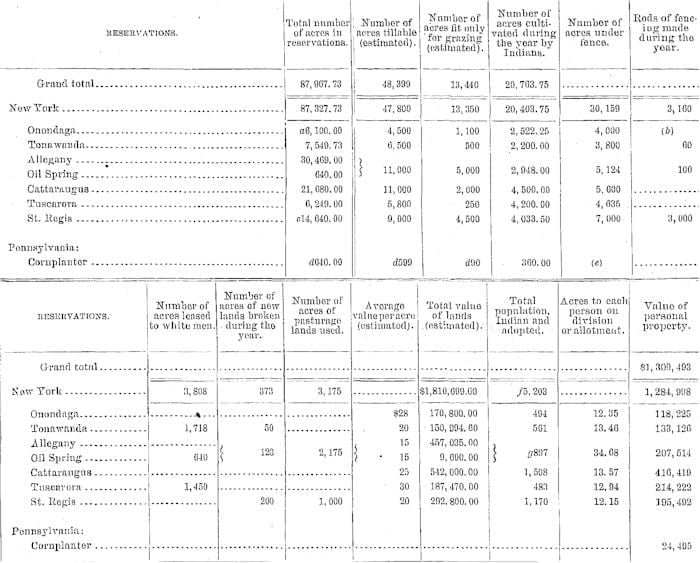
a. New York commission estimates acreage at 7,300.
b. Repairs only.
c. With swamp land, estimated at 15,280 acres.
d. Actual acreage 689, excess above 640 acres due to allowance for river bed.
e. Nearly all under fence,
f. Includes white and colored persons by marriage and adoption who may or may not have realty rights on allotment under Indian law.
g. Ninety-six white people unlawfully on the Allegany reservation but enumerated in the general census.
The personal property valuation of the Indians of the reservations of the Six Nations in New York is $1,284,998, and includes everything, which an Indian owns and can sell to another Indian.
Individual Wealth, The disparity in acquisition as between society grades is not very different from that in any community of ordinary white people. The large acquisitions; are few, and generally are the result of good management and reasonable industry. Inherited estates have been divided and scattered through improvidence, as among the white people. The Indian in New -York, as elsewhere, has fewer wants than his white neighbor; and is frequently more indolent or indifferent in the effort to acquire more than his actual necessities require.
Property Classed By Valuation

Value Of Houses And Household Effects
The total value of houses on the reservations of the Six Nations in New York is $226,067, and of household effects $63,916. The value of houses on the Cornplanter reservation, Pennsylvania, is $2,200; of household effects, $1,195.

The number and value of houses on the St. Regis reservation, probably inferior to all the others, are given in full, as an illustration of the value of Indian houses, as follows:
Number And Value Of Houses On The St. Regis Reservation

All Indians on the Six Nations reservations wear citizens’ clothes. The following table gives their number by sex and age, and their dwellings classified by materials:
Indian Population by Sex and Age, and Dwellings by Reservations, in New York and Pennsylvania
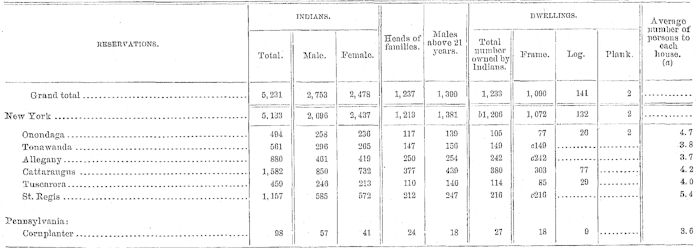
a. There are house accommodations provided for the number of persons given for each reservation.
b. Eighty-nine Indian houses are occupied by Indian renters ; the remainder by the owners..
c. Frame and log.
Agricultural Statistics
The following table gives the total amount and value of the agricultural products for the year 1890. The total area cultivated, including hay lands, is 20,764 acres; the value of products, $97,887.60. Many of the farmers and farm laborers of the Six Nations hire out during the farming season to their white neighbors, receiving cash for their labor. This, with o the products of their small farms, furnishes them a livelihood.
The leading articles of production were: bushels of wheat raised, 12,360; value. $10,053.60. Bushels of oats raised, 27,774; value, $11,588. Bushels of corn raised, 42,739; value, $17,252. Tons of hay cut, 3,427; value, $27,500. Bushels of potatoes raised, 21,319; value, $17,341. The total value of agricultural products raised by the Six Nations in New York and the Cornplanter Senecas in Pennsylvania for the year 1890 was $97,887.60.
Agricultural Products
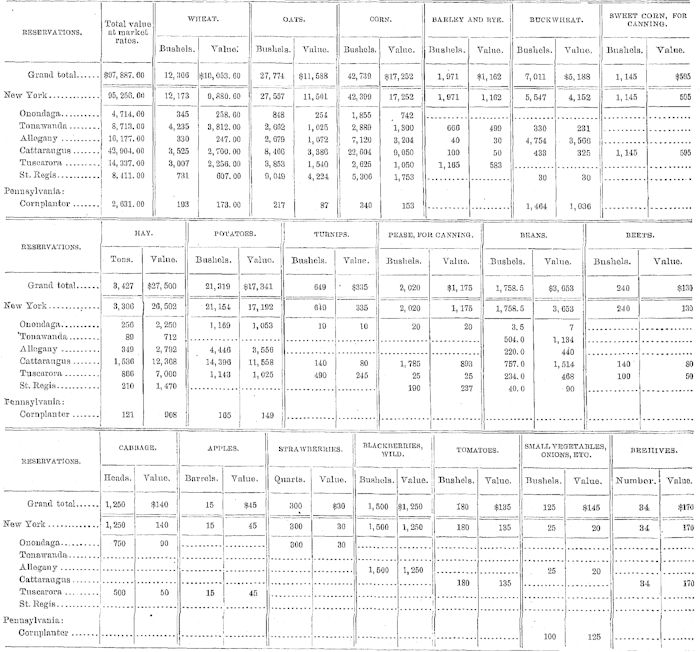
It is estimated that 4,132 cords of wood were cut on the 6 reservations in New York during the year ended June 30, 1890, mostly for home use.
The Six Nations in New York and Pennsylvania own live stock valued at $128,120, viz: 971 horses value $72,070; 4 mules, value $290; 1,246 swine, value $8,419; 9,540 domestic fowls, value $2,295; 1,990 cattle of all grades, value $44,790; and 28 sheep, value $256.
Live Stock

The total value of agricultural implements owned by the Six Nations is $63,195.50, including the Cornplanter reservation in Pennsylvania. This includes wagons and other vehicles in ordinary use. The value by reservations is as follows: Onondaga, $2,679; Tonawanda,, $4,991; Allegany, $4,691; Cattaraugus, $27,751.50; Tuscarora, $6,455; St. Regis, $12,135; Cornplanter, Pennsylvania, $4,493; total, $63,195.50.
Union Soldier And Sailor Element
The following statement shows the soldier and sailor element in the United States army in the War of the Rebellion; also widows of soldiers or sailors.
On the 23d of July, 1879, an effort was made on the part of the ex-soldiers belonging to the Seneca Nation to ascertain the names of those who served in the late war, with the result shown below, bat without obtaining the dates of enlistment or discharge.
The loss of papers, absence of papers with pension agents, lapse of time since the war, with absolute ignorance for years that any benefits would flow from service, rendered it almost impossible to obtain accurate data in many o cases, except where some had passed examination for Grand Army posts. Many enlisted under fictitious names. Some failed to pass final examination, but joined recruiting depots for a short time.
The enumeration of 1890 shows that the Onondagas furnished 16 soldiers, the Tonawanda, Senecas 13 soldiers and 1 marine, the Allegany Senecas 11 soldiers and 1 sailor, the Cattaraugus Senecas 87 soldiers (in 1879 the total was given as 67), the Tuscaroras 10 soldiers, and the St. Regis 23 soldiers, making a grand total of 162 soldiers and sailors.
The soldiers’ widows are: Onondagas, 2; Tonawanda Senecas, 1; Allegany Senecas, 2; Cattaraugus Senecas, 2; Tuscaroras, 5; St. Regis, 6; total, 18.
On June 1, 1890, there were 4 survivors who fought on the side of the United States in the war of 1812, and 4 others were reported as recently deceased.
Citations:
- There is no law for this, but by agreement and usage the St. Regis Indians can sue and be sued in the inferior courts of the State of New York, and judgment is always enforced. They have no courts among themselves.[↩]


